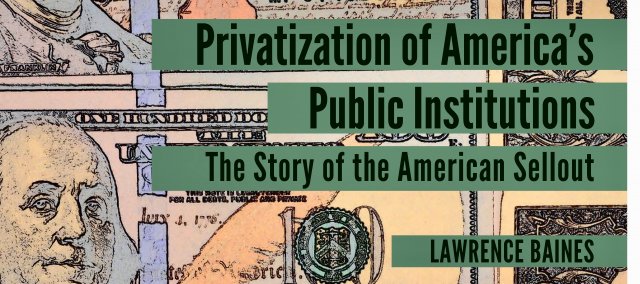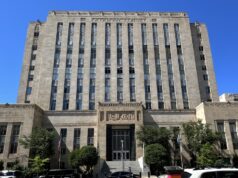Do you really know what goes on in our country? Behind the scenes or at the boardroom table, there are active systems and negotiations that you may be shocked to know about.
In my new book, Privatization of America’s Public Institutions: The Story of the American Sellout, I describe the transformation of institutions created for the benefit of all citizens — the military, K-12 schools, universities, and corrections — into enterprises focused on generating profits for a select few. The following excerpt about privatization of the military should give you a glimpse of information that should be concerning to all Americans.
Consider the following seven items:
1. About half of department of defense allocations go toward paying private contractors.
In 2015, the U.S. Department of Defense paid 44 percent of all federal discretionary spending allotted for defense to private contractors. Additional money for private contractors was drawn from the Overseas Contingency Operations (OCO) account, a multi-billion dollar “slush fund.” Most PSCs (private security contractors) make salaries that are multiple times higher than the salaries of U.S. military personnel. For example, in 2007 during the height of the Iraq War, an E-1 enlisted soldier stationed made $15,612 annually, while a private contractor who did laundry on base could make up to $80,000 and PSCs could make up to $300,000. Because private contractors are expected to “hold themselves accountable,” graft and corruption are more prevalent than in the military, where accountability systems are routine and expected. According to the Commission on Wartime Contracting in Iraq and Afghanistan, a “sobering, but conservative, estimate” is that private contractors defrauded the American government of $60 billion.
2. Few private contractors are Americans.
Up to 90 percent of private contractors are foreigners, so relatively few Americans benefit from the inundation of privatization during war. Of course, “local nationals…are often more difficult to screen and can be more easily infiltrated by hostile forces.”
3. Little is known about private contractors, though they significantly outnumber soldiers.
The backgrounds, whereabouts, and activities of private contractors are largely unknown. At times, there were hundreds of companies operating in Iraq and Afghanistan that employed more than 200,000 private contractors. They came from Nepal, Serbia, South Africa, Fiji, Chile, and neighboring countries in the Middle East. Little to nothing was known about their previous training, work history, or criminal records.
4. Private contractors can be hired and sent into battle right away.
While the American military cannot be mobilized without first acquiring several layers of governmental approval, including a formal vote from Congress, private contractors can be dispatched quietly, quickly, and with a minimum of fuss. For example, if a president wanted to “draw down American troop presence in Afghanistan,” he/she could simultaneously dispatch thousands of private contractors to take the place of soldiers without asking anyone’s permission. These thousands of private contractors would not be considered American troops and therefore, would not be considered official “boots on the ground.”
5. Private contractors may not be subject to American laws, military laws, or the laws of the country where they work.
After the revelations of gruesome torture at Abu Ghraib, 11 American soldiers were court-martialed and sentenced to jail. It is not widely known that, in addition to soldiers, private contractors also worked at Abu Ghraib. In fact, private contractors were in charge of the interrogation of prisoners. Those who investigated the abuses at Abu Ghraib believed that private contractors had been responsible for about half of the episodes of torture. However, while soldiers were court-martialed and sent to prison, not a single private contractor was ever charged with a crime. Beyond Abu Ghraib, recently released government documents confirm that hundreds of additional crimes, including murder and assault committed by PSCs, went unpunished and unacknowledged.
6. The American intelligence community relies heavily on private contractors.
After the end of the Cold War, following reductions in funding for the intelligence community, spy agencies were encouraged to utilize private contractors “as much as possible.” During the height of the Iraq War, the Office of the Director of National Intelligence (ODNI) proposed that “70 percent of the IC budget” might have been spent on private contracts. The book Spies for Hire concurs with the 70 percent figure. However, a recently-declassified 525-page investigation into the CIA’s interrogation techniques revealed that, in actuality, the number of CIA interrogators who were private contractors had grown to 85 percent.
7. R.O.T.C. has been outsourced to private companies.
The U.S. Army began outsourcing R.O.T.C. programs in 1997. Today, 100 percent of the Reserve Officer’s Training Corps (R.O.T.C.) programs in 270 colleges and universities in the United States are outsourced to private contractors. Although it was initially thought that using private contractors to run R.O.T.C. programs would be cheaper, a RAND study found that outsourcing R.O.T.C. did not save money.
Concerning using private contractors to run R.O.T.C., a military analyst writes, “If privatization of R.O.T.C. further promotes the de-professionalization of the army, it may have longer-term effects on the overarching values that motivate military service in the first place.” Since many commanders who lead the armed forces were once R.O.T.C. cadets, the cumulative effects of having private contractors in charge of officer training may not be optimal. In addition to officer training, the military also outsources security for State Department officials, education, aviation training, and the preparation of soldiers for the reserves.
If you need more, there’s more.
Privatization of America’s Public Institutions: The Story of the American Sellout describes the transformation of the military, k-12 public schools, public universities and colleges, and prisons into enterprises focused on generating profits for a select few. In many cases, privatization has limited public accessibility, promoted segregation, fueled declining standards, increased costs and reduced quality. And you need to know about it.























